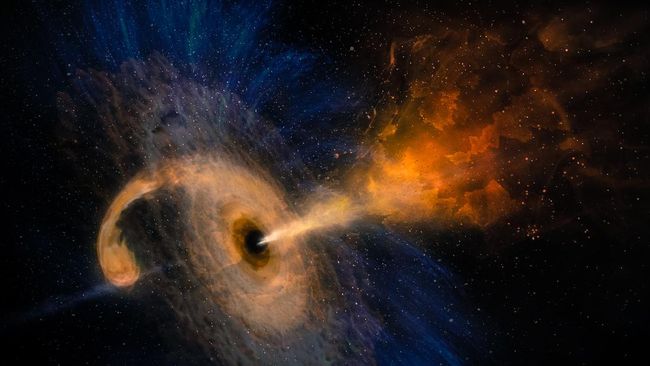Black hole or black holes are said to explode. There are several scenarios that could cause this mysterious space object to explode.
Scientist of the National Radio Astronomy Observatory (NRAO) Jeff Mangum said that black holes emit a large amount of energy that can be classified as an explosion, but this explosion doesn’t necessarily destroy the black hole after it occurs.
One way black holes can explode is that these objects are not completely black, which famous astrophysicist Stephen Hawking discovered in 1976.
ANNOUNCEMENT
Swipe to resume content
–
“In classical physics, nothing can get out of a hole,” said Samir Mathur, a physicist at Ohio State University. Live science.
“But Hawking found that with quantum mechanics, black holes slowly lose their energy indefinitely by emitting low-energy radiation called Hawking radiation,” he added.
As long as the black hole doesn’t suck in new matter, the object will slowly lose mass as it emits Hawking radiation.
But for the record, Hawking’s radiation slowly radiates its energy. A normal black hole with a mass several times that of the Sun emits about one photon, or packet of light, every year.
At that rate, a normal black hole would take 10 ^ 100 (10 with 0 to 100) years to completely evaporate.
However, Hawking noted that smaller black holes evaporate much faster. As a black hole gets smaller, it emits more radiation.
Then, in the last moments of its life, the black hole will emit more radiation, so quickly that it effectively acts like a bomb, releasing bursts of radiation and high-energy particles.
If a small (Earth-sized) black hole formed in the early universe, it would take several billion years to evaporate, meaning this primordial black hole would explode across the universe now.
In addition to Hawking radiation, a black hole is also expected to explode due to its very strong gravity.
Supermassive black holes are at the center of galaxies and sometimes large clusters of matter such as stars pass too close. When this happens, the star is torn apart by the effects of the tides and this tearing process releases an explosion of explosive energy.
Astronomers on Earth can witness the release of this energy in the form of short but intense beams of X-rays and gamma radiation.
Also, another way black holes explode is through a phenomenon called superradiants.
Rotating black holes create the ergosphere around their horizons. The ergosphere is an elongated region of space in which no spatial object can remain stationary.
Any particle or material that falls into the ergosphere region of the rotating black hole will begin to orbit around it.
Space-time that revolves around a black hole can also attract photons. If there are enough photons, they can bounce off each other and even bounce off other particles in space.
Reflections sometimes cause photons to escape from the ergosphere. But reflections sometimes cause photons to fall deeper into the black hole, where they gain energy.
These photons can also be scattered in a higher orbit, then fall back into a lower orbit.
With each iteration of the process and each journey around the black hole, the photon gains energy. This process is called “superradians”.
So when the photon finally escapes, it will have an enormous amount of energy compared to the first time it was in the ergosphere.
If enough photons participate in this series of processes, they can explode all at once with tremendous energy, becoming what is known as a “black hole bomb”.
(wool / wool)
–


